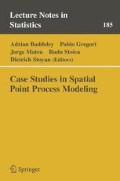Summary
Quantitative descriptions of animal species’ distributions at the ecosystem level are rare. In this study we used marked spatial point pattern analysis to characterize herd spatial distributions of several species comprising a savanna large herbivore community in Laikipia, central Kenya. Points are the herd centres, marks are the herd sizes. Previous research [15] identified possible discrepancies between prey and non-prey species on the basis of the nearest neighbour distance function. In this paper we make a similar distinction and analyse possible consequences. Analysis concentrated on Ripley’s K-function on several data subsets. A digitised boundary of the area has been included. The herd patterns of Thomson gazelle and of the plains zebra were modelled with a Strauss marked point process. The pattern of the Thomson gazelle showed a single mode, whereas that of the plains zebra showed multiple modes. This can be well explained by the ecosystem behavior (habitat specialist versus habitat generalist) of the two species.
Access this chapter
Tax calculation will be finalised at checkout
Purchases are for personal use only
Preview
Unable to display preview. Download preview PDF.
References
R. Arsenault and N. Owen-Smith. Facilitation versus competition in grazing herbivore assemblages. Oikos, 97:313–318, 2002.
A.J. Baddeley and R. Turner. Introduction to SPATSTAT, spatstat version 1.5–4. http://www.maths.uwa.edu.au/~adrian/spatstat/current/Intro.pdf.
P.J. Diggle. Statistical Analysis of Spatial Point Patterns, 2nd ed. Oxford University Press, 2003.
P.J. Diggle and A.G. Chetwynd. Second-order analysis of spatial clustering for inhomogeneous populations. Biometrics, 47:1155–1163, 1991.
N. Georgiadis. Numbers and distribution of large herbivores in laikipia district: sample counts for february and september 1997. Laikipia Wildlife Forum, Nanyuki, Kenya, 1997.
N. Georgiadis, M. Hack and K. Turpin. The influence of rainfall on zebra population dynamics: implications for management. Journal of Applied Ecology, 40:125–136, 2003.
F.P. Kelly and B.D. Ripley. On strauss’s model for clustering. Biometrika, 63:357–360, 1976.
H. Lamprey. Ecological separation of the large mammal species in the tarangire game reserve, tanganyika. East African Wildlife Journal, 2:1–46, 1963.
J. Ohser. On estimators for the reduced second moment measure of point processes. Mathematische Operationsforschung und Statistik series Statistics, 14(1):63–71, 1983.
N.V. Petersen. A spatio-temporal model for fmri data. In Proceedings of the Eleventh European Young Statisticians Meeting, Marly-le-Roi, pages 196–201, 1999.
H.H.T. Prins and H. Olff. Species richness of african grazers assemblages: Towards a functional explanation. In D.M. Newbery, H.H.T. Prins and H. Brown, editors, Dynamics of Tropical Communities, pages 449–490. Blackwell Science, 1998.
B.D Ripley. Statistical Inference for Spatial Processes. Cambridge University Press, Cambridge, 1988.
B.D. Ripley. Spatial Statistics — 2nd edition. Wiley, 2004.
A. Stein, N. Georgiados and W. Khaemba. Spatial statistics to quantify patterns of herd dispersion in a savanna herbivore community. In A.J. Baddeley, P. Gregori, J. Mateu, R. Soica and D. Stoyan, editors, Spatial point process modelling and its applications, pages 239–260. Publicacions de la Universitat Jaume I, 2004.
A. Stein, N. Georgiados and W. Khaemba. Patterns of herd dispersion in savanna herbivore communities. In F. van Langeveld and H.H.T. Prins, editors, Spatial and temporal dynamics of foraging. Kluwer, (in press).
D. Strauss. A model for clustering. Biometrika, 63:467–475, 1975.
M.M. Voeten. Living with wildlife: Coexistence of wildlife and livestock in an East African Savannah system. PhD thesis, Wageningen University, 1999.
P.A. Walker. Modelling wildlife distributions using a geographic information system: Kangaroos in relation to climate. Journal of Biogeography, 17:279–289, 1990.
W. Wint. Drylands: Sustainable use of rangelands into the twenty-first century. In V.R. Squires and A.E. Sidahmed, editors, Resource assessment and environmental monitoring using low level aerial surveys, pages 277–301. IFAD publication, 1998.
Author information
Authors and Affiliations
Editor information
Editors and Affiliations
Rights and permissions
Copyright information
© 2006 Springer Science+Business Media Inc.
About this chapter
Cite this chapter
Stein, A., Georgiadis, N. (2006). Spatial Marked Point Patterns for Herd Dispersion in a Savanna Wildlife Herbivore Community in Kenya. In: Baddeley, A., Gregori, P., Mateu, J., Stoica, R., Stoyan, D. (eds) Case Studies in Spatial Point Process Modeling. Lecture Notes in Statistics, vol 185. Springer, New York, NY. https://doi.org/10.1007/0-387-31144-0_14
Download citation
DOI: https://doi.org/10.1007/0-387-31144-0_14
Publisher Name: Springer, New York, NY
Print ISBN: 978-0-387-28311-1
Online ISBN: 978-0-387-31144-9
eBook Packages: Mathematics and StatisticsMathematics and Statistics (R0)

